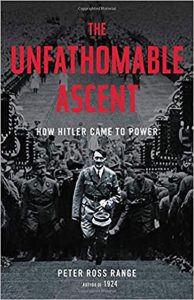The Rise of Adolf Hitler: From Beer-Hall Haranguer to Chancellor of the German Reich (1925 to 1933) Book Review
In 1925, the then-wannabe political leader of Germany, Adolf Hitler, was 36 years of age. He was a card-carrying member of the fairly new Nazi Party (NSDAP). In fact, he was member 555. At that time, there were around 40 political parties in the German state.
Germany was a political and economic mess. It was still hurting from the effects of WWI, which included the high reparation payments it had to make to the Allied Powers. No one political party could gain control of the government.
In 1923, Hitler and his gang had attempted a coup d’etat. It was a bloody disaster. Hitler was lucky he wasn’t killed, although he did end up in prison with a conviction for high treason and a sentence of five years.
After serving only a year in prison, Hitler was pardoned by the Bavarian Supreme Court over the strong objections of the state prosecutor. By the time he got out of prison, the growing Nazi party had about 15 of its members elected to the German Parliament, k/a the Reichstag.
It was also in 1925 that Hitler’s biographical book, “Mein Kampf,” came out. It was moderately successful. The tome was Hitler’s political manifesto. It quickly became the bible of the emerging Nazi party.
 It covered Hitler’s distorted views of WWI, the Nazi’s failed coup, his trial for treason and his racist views of the Jewish people. The latter topic included Hitler falsely blaming the Jews for Germany losing WWI.
It covered Hitler’s distorted views of WWI, the Nazi’s failed coup, his trial for treason and his racist views of the Jewish people. The latter topic included Hitler falsely blaming the Jews for Germany losing WWI.
The author, Peter Ross Range, labeled Hitler, “a nobody from nowhere.” He raised this relevant question about him: “How did an unknown failed painter from Austria weave his way through the dense thicket of post-First World War politics to become the last man standing when Germany’s democracy crumbled?”
Range, in his recently released book, “The Unfathomable Ascent: How Hitler Came to Power,” took 448 pages to answer his own question. I think he did a pretty darn good job coming up with his answer, too. It’s also a well-written and fully documented effort.
I’m not surprised by its early success, since I had also read Range’s book, “The Year That Made Hitler:1924.” It told the compelling story of how Hitler, at a critical time in his career, 1924, gave rebirth to his political ambitions, including writing his book, “Mein Kampf.”
Hitler’s climb to power, Range wrote, was a case, sometimes of “bluster, accidents, and a train wreck of epic proportions laced with flashes of political skills.” The author was also clear about the numerous talents and hard work that Hitler and his gang of militants brought to the table.
Range put it this way: The Nazis were “dogged at organizing,” and displayed a “brilliant political ground game, along with an exceptional rhetorical gift.”
The title of Range’s book came from a comment made by a close Hitler confidante, Hans Frank. He had served the Fuhrer as the governor-general of occupied Poland. Frank called the Nazi’s leader’s climb to dominance an “unfathomable ascent.”
Germany’s governments in the 20’s and early 30s were shaky to say the least. Its “virgin democracy” was weak, along with a “profound splintering of the German body politics” coupled with the “untimely deaths of statesmen who might have thwarted Hitler’s climb,” Range wrote.
On top of all that Hitler’s rise to power profited from the “onset of the Great Depression,” Range continued. It didn’t help, too, that the German leaders at that time continued to “underestimate” Hitler and the power and influence of his growing political machine. The incompetence of some of Hitler’s “contemporaries simply added to the problem.”
By the spring of 1932, however, Hitler was still not close to grabbing power. Then, an official of the government, Wilhem Groner, the Minister of Defense, convinced President von Hindenburg to “ban the Nazi Storm Troopers.” The order backfired! Groener soon got the boot.
His successor, General Kurt von Schleicher, made an even bigger mistake. He thought he could control Hitler in the formation of another coalition government. Cutting to the chase, Hitler’s party in July of 1932, gained 230 seats in the Reichstag, which constituted 37 percent of the vote in the election. Hermann Goring, Hitler’s number one crony, was elected president of the Reichstag.
By late January 1933, the cunning Hitler used the Nazi’s power in the Reichstag in the formation of yet another coalition government. In this one, he was named as the Chancellor! A politico who voted for Hitler, Alfred Hugenberg, according to Range, made this comment about his role in that process: “Yesterday, I did the stupidest thing in my life. I joined forces with the greatest demagogue in world history.
After only about a month in power, some idiot decided to put a torch to the German Reichstag. Hitler blamed the crime on the Communists, who he insisted were planning a coup. This was just more lies from the Nazi camp.
By the summer of 1934, Hitler was ready to see “heads roll” and roll they did. Range estimates “several hundred people were murdered.” They included two of Hitler’s oldest cronies – Gregor Strasser and Ernst Rohm. General von Schleicher also made Hitler’s “hit list.”
That notorious blood-stained happening is remembered as, “The Night of the Long Knives.” It became emblematic of the horror story that was to follow. It was to last till Hitler’s death and the Nazi’s defeat in WWII, on May 7, 1945.

Bill Hughes is an attorney, author, actor and photographer. His latest book is “Byline Baltimore.” It can be found at: https://www.amazon.com/William-Hughes/e/B00N7MGPXO/ref=dp_byline_cont_book_1

